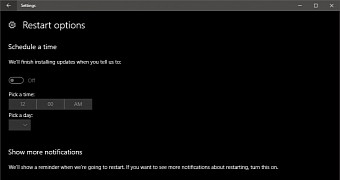One of the changes that Microsoft is making in Windows 10 with the upcoming Creators Update is giving users more control over the updates they install, finally killing off forced reboots once and for all.
In the past, Windows computers automatically rebooted to complete the installation of certain updates, and this was undoubtedly frustrating not only for home users but also for enterprises where a system restart interrupted work all of a sudden.
Starting with the Windows 10 Creators Update, Microsoft is introducing a snoozing update feature that makes it possible for users to pause a specific update for up to 3 days and thus find the most convenient time for installing it.
Options to pause updates have already been implemented in Windows 10 Creators Update preview builds, and Microsoft says it’s all because users want more control over the updates they install.
“Prior to the Creators Update, Windows 10 made most of the decisions for you regarding when updates would be installed and didn’t provide ways to tailor the timing to your specific needs. What we heard back most explicitly was that you want more control over when Windows 10 installs updates. We also heard that unexpected reboots are disruptive if they happen at the wrong time,” John Cable, Director of Program Management within the Windows Servicing and Delivery (WSD) team, said.
More options
In addition to the snooze option, Microsoft is also offering more options for Active Hours, again enabling users to choose the best time for installing an update.
A new icon also made its way to Windows Update, so you’ll easily know if your system is fully up to date without actually pressing the “Check for updates” button.
All these options will be shipped to users in the Creators Update which, according to sources, is projected to see daylight in April. They are already available in preview builds, and anyone can install them by joining the Windows Insider program, but these releases include bugs and issues that don’t typically exist in stable Windows versions.

 14 DAY TRIAL //
14 DAY TRIAL //